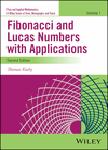版权所有:内蒙古大学图书馆 技术提供:维普资讯• 智图
内蒙古自治区呼和浩特市赛罕区大学西街235号 邮编: 010021

丛 书 名:Pure and Applied Mathematics: A Wiley Series of Texts, Monographs and Tracts
版本说明:2
I S B N:(纸本) 9781118742129
出 版 社:John Wiley & Sons Inc.
出 版 年:2017年
主 题 词:Fibonacci numbers Lucas numbers Golden Ratio combinatorics number theory
学科分类:07[理学] 0701[理学-数学] 070101[理学-基础数学]
摘 要:Praise for the First Edition “ …beautiful and well worth the reading … with many exercises and a good bibliography, this book will fascinate both students and teachers. Mathematics Teacher Fibonacci and Lucas Numbers with Applications, Volume I, Second Edition provides a user-friendly and historical approach to the many fascinating properties of Fibonacci and Lucas numbers, which have intrigued amateurs and professionals for centuries. Offering an in-depth study of the topic, this book includes exciting applications that provide many opportunities to explore and experiment. In addition, the book includes a historical survey of the development of Fibonacci and Lucas numbers, with biographical sketches of important figures in the field. Each chapter features a wealth of examples, as well as numeric and theoretical exercises that avoid using extensive and time-consuming proofs of theorems. The Second Edition offers new opportunities to illustrate and expand on various problem-solving skills and techniques. In addition, the book features: • A clear, comprehensive introduction to one of the most fascinating topics in mathematics, including links to graph theory, matrices, geometry, the stock market, and the Golden Ratio • Abundant examples, exercises, and properties throughout, with a wide range of difficulty and sophistication • Numeric puzzles based on Fibonacci numbers, as well as popular geometric paradoxes, and a glossary of symbols and fundamental properties from the theory of numbers • A wide range of applications in many disciplines, including architecture, biology, chemistry, electrical engineering, physics, physiology, and neurophysiology The Second Edition is appropriate for upper-undergraduate and graduate-level courses on the history of mathematics, combinatorics, and number theory. The book is also a valuable resource for undergraduate research courses, independent study projects, and senior/graduate theses, as well as a useful resource for computer scient